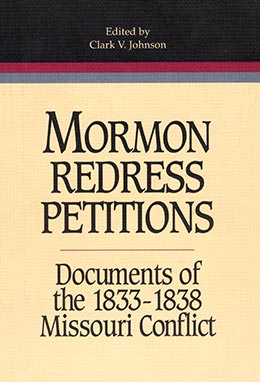Introduction to Part II
Introduction to Part II in Mormon Redress Petitions: Documents of the 1833–1838 Missouri Conflict, ed. Clark V. Johnson (Provo, Utah: Religious Studies Center, Brigham Young University, 1992), 101–102.
In 1839 the leaders of The Church of Jesus Christ of Latter-day Saints began their first appeal for redress from the federal government for their losses in Missouri. Part II consists of the documents of this first appeal which include a general introductory petition, referred to as a memorial, and many individual petitions. The Prophet Joseph Smith himself led the Mormon delegation which consisted of Elias Higbee, Sidney Rigdon, and Orrin Porter Rockwell. They left Nauvoo on 29 October 1839 and traveled to Quincy, Illinois, where they stayed an extra day because Sidney Rigdon had become ill. In Quincy they were joined by Robert Foster, a medical doctor who consented to travel with them to nurse Rigdon (HC 4:19–20). By the time they reached Columbus, Ohio, Rigdon had become so ill that Joseph Smith and Elias Higbee left him there with Rockwell and Foster and continued on to Washington, D.C. (HC 4:21).
Joseph Smith and Elias Higbee arrived in Washington on Thursday, 28 November 1839. The following day they met with President Martin Van Buren. After he had read one of their letters of introduction he said, “with a kind of half frown, . . . What can I do? I can do nothing for you! If I do anything, I shall come in contact with the whole state of Missouri” (HC 4:40). However, he promised to reconsider the matter.
Most histories show that Joseph had only one interview with the President during his visit to Washington. Yet it is possible that he had a second meeting with President Van Buren, for on Thursday, 6 February 1840, Joseph recorded, “It was with great reluctance he [Van Buren] listened to our message, which, when he had heard, he said: ‘Gentleman, your cause is just, but I can do nothing for you;’ and ‘If I take up for you I shall lose the vote of Missouri’“ (HC 4:80).
Rigdon, Rockwell, and Foster joined the Prophet and Higbee on 23 December 1839. From that time through 6 February 1840 the members of the delegation tried to present the Mormon cause before the U.S. Congress. Instead of allowing the Mormons to present their petitions directly to Congress, the Senate voted to refer the matter to the Senate Judiciary Committee. The Prophet Joseph Smith recorded that besides the memorial signed by himself, Sidney Rigdon, and Elias Higbee, they presented 491 individual claims to Congress “leaving a multitude more of similar bills hereafter to be presented” (HC 4:74).
Frustrated, Joseph, Porter Rockwell, and Dr. Foster left for Nauvoo on 20 February 1840 (HC 4:81). Elias Higbee and Sidney Rigdon remained in Washington a few weeks longer, but met with little success. On 9 March 1840, Higbee wrote to the Prophet Joseph Smith that Senator Richard M. Young of Illinois had made a last attempt to help the Saints; Higbee reported that he and Rigdon would return to Nauvoo when he received the final report from the Senate Judiciary Committee (HC 4:94).
As Higbee had expected, the Committee determined that the federal government could not intervene in a state’s right “to redress the wrongs of its own citizens” (HC 4:92). On 24 March 1840, Higbee wrote that he had withdrawn “the accompanying papers” (presumably the petitions) and would return to Nauvoo immediately (HC 4:98–99).
Today the individual petitions that Higbee withdrew are housed in the LDS Historical Department. However, the memorial that was sent with this First Appeal remained in Washington, D.C., and is found in the National Archives.
